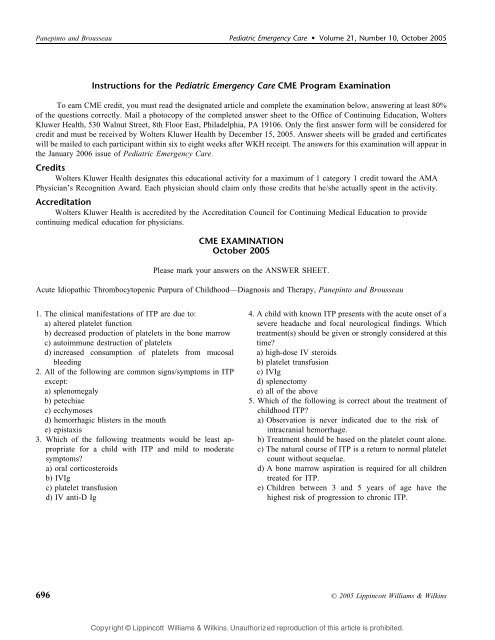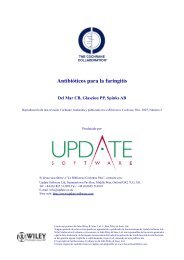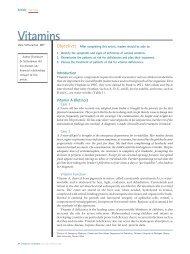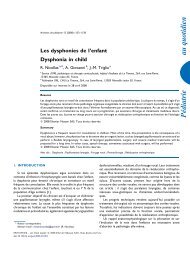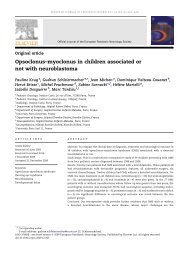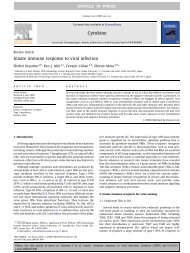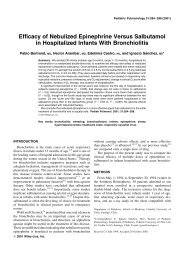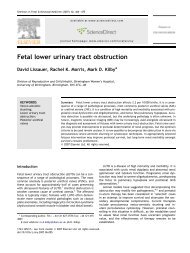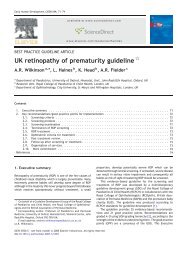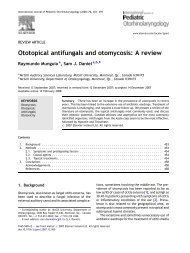Acute Idiopathic Thrombocytopenic Purpura of Childhood ... - sepeap
Acute Idiopathic Thrombocytopenic Purpura of Childhood ... - sepeap
Acute Idiopathic Thrombocytopenic Purpura of Childhood ... - sepeap
You also want an ePaper? Increase the reach of your titles
YUMPU automatically turns print PDFs into web optimized ePapers that Google loves.
Panepinto and Brousseau Pediatric Emergency Care Volume 21, Number 10, October 2005<br />
Instructions for the Pediatric Emergency Care CME Program Examination<br />
To earn CME credit, you must read the designated article and complete the examination below, answering at least 80%<br />
<strong>of</strong> the questions correctly. Mail a photocopy <strong>of</strong> the completed answer sheet to the Office <strong>of</strong> Continuing Education, Wolters<br />
Kluwer Health, 530 Walnut Street, 8th Floor East, Philadelphia, PA 19106. Only the first answer form will be considered for<br />
credit and must be received by Wolters Kluwer Health by December 15, 2005. Answer sheets will be graded and certificates<br />
will be mailed to each participant within six to eight weeks after WKH receipt. The answers for this examination will appear in<br />
the January 2006 issue <strong>of</strong> Pediatric Emergency Care.<br />
Credits<br />
Wolters Kluwer Health designates this educational activity for a maximum <strong>of</strong> 1 category 1 credit toward the AMA<br />
Physician’s Recognition Award. Each physician should claim only those credits that he/she actually spent in the activity.<br />
Accreditation<br />
Wolters Kluwer Health is accredited by the Accreditation Council for Continuing Medical Education to provide<br />
continuing medical education for physicians.<br />
CME EXAMINATION<br />
October 2005<br />
Please mark your answers on the ANSWER SHEET.<br />
<strong>Acute</strong> <strong>Idiopathic</strong> <strong>Thrombocytopenic</strong> <strong>Purpura</strong> <strong>of</strong> <strong>Childhood</strong>—Diagnosis and Therapy, Panepinto and Brousseau<br />
1. The clinical manifestations <strong>of</strong> ITP are due to:<br />
a) altered platelet function<br />
b) decreased production <strong>of</strong> platelets in the bone marrow<br />
c) autoimmune destruction <strong>of</strong> platelets<br />
d) increased consumption <strong>of</strong> platelets from mucosal<br />
bleeding<br />
2. All <strong>of</strong> the following are common signs/symptoms in ITP<br />
except:<br />
a) splenomegaly<br />
b) petechiae<br />
c) ecchymoses<br />
d) hemorrhagic blisters in the mouth<br />
e) epistaxis<br />
3. Which <strong>of</strong> the following treatments would be least appropriate<br />
for a child with ITP and mild to moderate<br />
symptoms?<br />
a) oral corticosteroids<br />
b) IVIg<br />
c) platelet transfusion<br />
d) IV anti-D Ig<br />
4. A child with known ITP presents with the acute onset <strong>of</strong> a<br />
severe headache and focal neurological findings. Which<br />
treatment(s) should be given or strongly considered at this<br />
time?<br />
a) high-dose IV steroids<br />
b) platelet transfusion<br />
c) IVIg<br />
d) splenectomy<br />
e) all <strong>of</strong> the above<br />
5. Which <strong>of</strong> the following is correct about the treatment <strong>of</strong><br />
childhood ITP?<br />
a) Observation is never indicated due to the risk <strong>of</strong><br />
intracranial hemorrhage.<br />
b) Treatment should be based on the platelet count alone.<br />
c) The natural course <strong>of</strong> ITP is a return to normal platelet<br />
count without sequelae.<br />
d) A bone marrow aspiration is required for all children<br />
treated for ITP.<br />
e) Children between 3 and 5 years <strong>of</strong> age have the<br />
highest risk <strong>of</strong> progression to chronic ITP.<br />
696 n 2005 Lippincott Williams & Wilkins<br />
Copyright © Lippincott Williams & Wilkins. Unauthorized reproduction <strong>of</strong> this article is prohibited.


